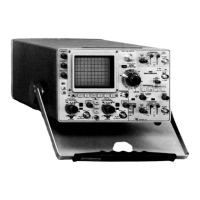Circuit Description—485/R 485 Service
the focus electrode. The focus pot R1640 is set for
optimum focus at low intensity level.
Beam Current Limit
The amplifier consisting of Q1544, Q1546, and Q1548
controls the voltage to the INTENSITY and B INTENSITY
controls.
For sweep speeds of 50 ms/div and slower and X-Y, the
current in resistor R1536, about 5juA, pulls the base of
Q1544 up to about +6 V. All three transistors are saturated.
The average beam current of the CRT post-accelerator is
available at the low-voltage end of the high voltage
multiplier and is also connected to the base of Q1544.
When the beam current is zero, the 5pA current of R1536
flows into the base of the saturated Q1544. When due to
high intensity, the average beam current exceeds the 5pA
value, the voltage at Q1544 base decreases at a rate
determined by the net discharge current delivered to
Cl 537. As this voltage goes negative, the transistors Q1544,
Q1546, and Q1548 come out of saturation, and into the
control range, when the input base voltage has dropped to
+4 V. In the linear range the three-stage amplifier gain is
about —5 V. Input voltages of +4 V and +1 V result in
output voltages of —15 V and 0 V respectively.
The positive going voltage at the intensity controls
(Q1548C) gives reduced Z-Axis drive and less beam current.
In the linear range of the amplifier the output voltage
stabilizes at a voltage resulting in the 5 mA average beam
current.
The beam current limit becomes 20 pA if the additional
15pA current of R1534 is not pulled away by closed A1
contact on S1420 (sweep 50 ms/div and slower) or by X-Y
switch closure. Diodes CR1532, CR1534, and CR1535 are
involved in this switching.
The time response to an overcurrent is in two parts: A
delay for the input to charge to a voltage where the output
transistor comes out of saturation, followed by a linear
response time constant. Initial delay is 10 ms for maximum
beam current and increases for smaller over-currents. The
linear response time constant is 10 ms.
Power Supply Shutdown Caused by Excessive
Beam Current
If, due to some failure, the control loop is unable to
keep the average beam current within either the 5pA or
20 pA limit, the voltage at the amplifier input discharges
below the +1 V level. As the voltage reaches about +0.5 V
the Q1546 collector voltage is approximately —0.9 V, and
operates the power supply shutdown by connection
through diode CR1959.
To prevent shutdown being signaled during the first
200 ms of instrument turn-on. Cl 538 (thru R1538) pro
vides a delay to compensate for charging currents in the
CRT post-accelerator supply. Diode CR1533 biases the
15pA network so that this current is connected to the
Q1544 base before it can drop to the +0.5 V shutdown
voltage level. Thus, the higher beam current, (approxi
mately 28 nA) is always required to trip shutdown.
In troubleshooting the instrument it may become
necessary to disable the beam limit or beam shutdown
loops. This can be done by grounding TP1544 at the
collector of Q1544.
CRT CONTROL CIRCUITS
The ASTIG adjustment R1799, which is used in con
junction with the FOCUS adjustment R1640 to obtain a
well defined display, varies the positive level on the
astigmatism grid. Geometry adjustment R1792 varies the
positive potential on the mesh to control the overall
geometry of the display.
Two adjustments control the trace alignment by varying
the magnetic field around the CRT. Y Axis Align adjust
ment R1794 controls the current through L1794, which
affects the CRT beam after vertical deflection, but before
horizontal deflection. Therefore, it affects only the vertical
(Y) components of the display. TRACE ROTATION
adjustment R1790 controls current through LI 790 and
affects both the vertical and horizontal rotation of the
beam.
R1796 adjust the voltage on the compensation plates to
the average vertical deflection plate structure potential. If
this adjustment is not precise, proper focusing can not be
achieved by the focus control.
AUTO-FOCUS CIRCUIT
The Auto-Focus circuit provides an output voltage that
keeps the display focused for all settings of INTENSITY
control. To do this, it amplifies the intensity control
voltages in a non-linear fashion and gates the B INTENSITY
function.
U1710 provides gating, limiting and part of the shaping
of the auto-focus. Gating is of the B INTENSITY current
pin 1, by the A-B control function pin 15. In ALTernate
sweep operation the A-B control switches from —0.1 V to
+0.9 V at the end of A sweep (A display), steering the B
INTENSITY current to the output, pin 8. The sweep
holdoff time, a minimum of 300 ns, is used for the
amplifier that follows to settle to the new focus voltage for
3-14

